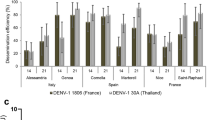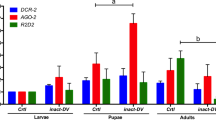Abstract
DENGUE VIRUSES, which have four serotypes, belong to the genus flavivirus of Togaviridae and are transmitted by mosquitoes such as Aedes aegypti or Aedes albopictus. Human infection with dengue viruses is manifested by disease varying in severity from mild undiflferentiated fever to grave haemorrhagic fever, which is widespread in Southeast Asia1–3. Persistently infected cultures can be established when cultured mosquito cells are infected with Togaviridae, either alphaviruses or flavi viruses4–7. Analysis of mosquito cells persistently infected with alphaviruses has shown characteristics such as the generation of small-plaque and temperature-sensitive (ts) viruses7–9, and resistance to superinfections with the homologous but not the heterologous viruses6,10. In contrast, little is known about mosquito cells persistently infected with flavi viruses4,11,12. Here, in experiments with A. albopictus (Singh) cells persistently infected with dengue viruses, I show that such cultures produce ts viruses and become resistant to all the types of dengue viruses.
This is a preview of subscription content, access via your institution
Access options
Subscribe to this journal
Receive 51 print issues and online access
$199.00 per year
only $3.90 per issue
Buy this article
- Purchase on Springer Link
- Instant access to full article PDF
Prices may be subject to local taxes which are calculated during checkout
Similar content being viewed by others
References
Clarke, D. H. & Casals, J. in Viral and Rickettsial Infections of Man (eds Horsfall, F. L. Jr & Tamm. I.) 606–658 (Lippincott, Philadelphia, 1965).
Hammon, W. McD., Rudnick, A. & Sather, G. E. Science 131, 1102–1103 (1960).
Halstead, S. B. Bull. Wld Hlth Org. 35, 3–15 (1966).
Rehacek, J. Acta virol. 12, 340–346 (1968).
Peleg, J. J. gen. Virol. 5, 463–471 (1969).
Stollar, V. & Shenk, T. E. J. Virol. 11, 592–595 (1973).
Stollar, V., Peleg, J. & Shenk, T. E. Intervirology 2, 337–344 (1974).
Shenk, T. E., Koshelnyk, K. A. & Stollar, V. J. Virol. 13, 439–447 (1974).
Igarashi, A., Koo, R. & Stollar, V. Virology 82, 69–83 (1977).
Peleg, J. & Stollar, V. Arch. ges. Virusforsch. 45, 309–318 (1974).
Banerjee, K. & Singh, K. R. P. Ind. J. med. Res. 56, 812–814 (1968).
Sinarachatanant, P. & Olson, L. C. J. Virol. 12, 275–283 (1973).
Igarashi, A. J. gen. Virol. 40, 531–544 (1978).
Igarashi, A. & Mantani, M. Biken J. 17, 87–93 (1974).
Singh, K. R. P. Curr. Sci. 36, 506–508 (1967).
Banerjee, K. & Singh, K. R. P. Ind. J. med. Res 57, 1003–1005 (1969).
Peleg, J. Curr. Topics Microbiol. Immun. 55, 155–161 (1971).
Peleg, J. Ann. N. Y. Acad. Sci. 266, 204–213 (1975).
Preble, O. T. & Youngner, J. S. J. infect. Dis. 131, 467–473 (1975).
Author information
Authors and Affiliations
Rights and permissions
About this article
Cite this article
IGARASHI, A. Characteristics of Aedes albopictus cells persistently infected with dengue viruses. Nature 280, 690–691 (1979). https://doi.org/10.1038/280690a0
Received:
Accepted:
Issue Date:
DOI: https://doi.org/10.1038/280690a0
This article is cited by
-
Performance of commercial dengue NS1 ELISA and molecular analysis of NS1 gene of dengue viruses obtained during surveillance in Indonesia
BMC Infectious Diseases (2013)
-
Detection and sequencing of defective viral genomes in C6/36 cells persistently infected with dengue virus 2
Archives of Virology (2013)
Comments
By submitting a comment you agree to abide by our Terms and Community Guidelines. If you find something abusive or that does not comply with our terms or guidelines please flag it as inappropriate.



